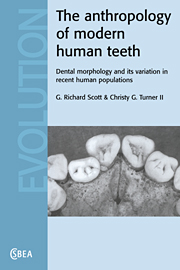 The Anthropology of Modern Human Teeth
The Anthropology of Modern Human Teeth Book contents
- Frontmatter
- Dedication
- Contents
- Acknowledgments
- Prologue
- 1 Dental anthropology and morphology
- 2 Description and classification of permanent crown and root traits
- 3 Biological considerations: ontogeny, asymmetry, sex dimorphism, and intertrait association
- 4 Genetics of morphological trait expression
- 5 Geographic variation in tooth crown and root morphology
- 6 Establishing method and theory for using tooth morphology in reconstructions of late Pleistocene and Holocene human population history
- 7 Tooth morphology and population history
- Epilogue
- Appendixes
- References
- Index
4 - Genetics of morphological trait expression
Published online by Cambridge University Press: 05 September 2015
- Frontmatter
- Dedication
- Contents
- Acknowledgments
- Prologue
- 1 Dental anthropology and morphology
- 2 Description and classification of permanent crown and root traits
- 3 Biological considerations: ontogeny, asymmetry, sex dimorphism, and intertrait association
- 4 Genetics of morphological trait expression
- 5 Geographic variation in tooth crown and root morphology
- 6 Establishing method and theory for using tooth morphology in reconstructions of late Pleistocene and Holocene human population history
- 7 Tooth morphology and population history
- Epilogue
- Appendixes
- References
- Index
Summary
Introduction
McKusick's (1990) massive compendium Mendelian Inheritance in Mancatalogs more than 12,000 autosomal dominant, autosomal recessive, and X-linked phenotypes, only 41 of which are dental variables. Fully one-third of these are developmental defects of the enamel and dentine, including several varieties of amelogenesis imperfecta.After such defects, seven phenotypes with allegedly simple modes of inheritance are variants of hypodontia (missing teeth). The remaining dental traits run the gamut from fused teeth and dental ankylosis to syndromes involving dental abnormalities. With few exceptions, these dental phenotypes are rare, reported in only one or a few families.
For commonly occurring crown and root traits, McKusick notes only six with presumed simple modes of inheritance. Listed as autosomal dominants are Carabelli's anomaly, upper lateral incisor interruption grooves (dens invaginatus),premolar odontomes (dens evaginatus),upper central incisor winging, and shovel-shaped incisors. Taurodontism is listed as an autosomal recessive. Judiciously, McKusick marks none of these entries with an asterisk, his method for signifying phenotypes with well established modes of inheritance.
Despite the seeming paucity of simple genetic markers in the dentition, it is almost axiomatic that tooth development in general and dental morphology in particular are under strong hereditary control. Gabriel (1948:7) asserts ‘there can be no doubt of a genetic pattern for tooth morphology extending to even minute detail of root formation.’ Kraus and Furr (1953:554) add ‘It often has been stated in the past, and constantly reiterated at the present time, that the entire dentition, in its gross morphology, is governed strictly by the action of genes.’ From an anthropological vantage, Moorrees (1962:101) notes that ‘The use of the dentition as a criterion of race stems from the recognition that form and size of the teeth, for the most part, are genetically determined.’ In a review of the genetics of dental development, Garn (1977:82) concludes ‘It is true that by all conventional tests, dental development is to a larger extent under genetic control than is known for most other calcified tissues, including even the round bones of the hand and foot.’ Comments to this effect are common in the dental literature, but deducing the nature of this genetic control has not been straightforward for any facet of normal human dental variation, including tooth size, morphology, and number.
- Type
- Chapter
- Information
- The Anthropology of Modern Human TeethDental Morphology and its Variation in Recent Human Populations, pp. 131 - 164Publisher: Cambridge University PressPrint publication year: 1997


